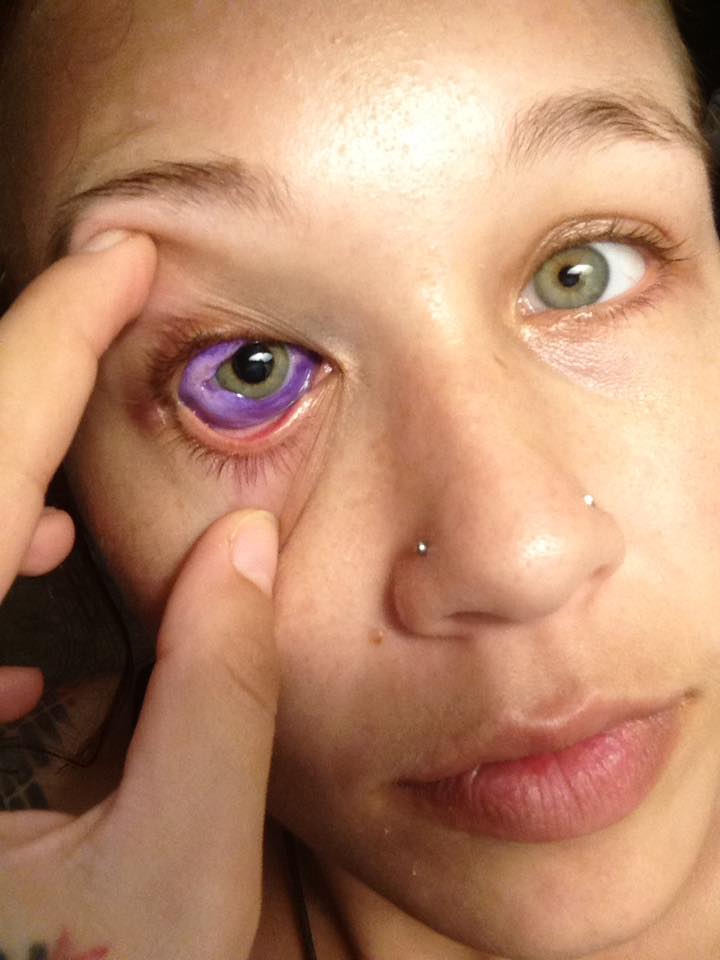A Canadian woman nearly lost her eye after undergoing a dangerous and increasingly popular procedure to permanently color in the whites of her eyes.
Catt Gallinger, a 24-year-old model, had sought out a “sclera tattoo” — a relatively new trend in which people get ink injected into their eyeball to turn the sclera, or the white part of the eyeball, into a different color. Gallinger’s procedure last month went wrong and left purple ink oozing out of her eye, which quickly became swollen, infected and painful.
“It hurt. It burned,” Gallinger told TIME on Friday. “At its worst, it’s like having a migraine and then also being punched in the face at the same time. It’s taken a big toll on my mental health.”
Gallinger said she expects to undergo eye surgery to remove the ink next week, but the vision in her right eye will likely never go back to normal. She’s now speaking out against the dangers of sclera tattoos to spread awareness about the life-changing risks the procedure poses.
Here’s what to know about the trend. (Warning: Graphic photo below.)
How do you get a sclera tattoo?
A sclera tattoo is not exactly a tattoo, although it is permanent. It happens when a mixture of ink and saline is injected into the eye through a small needle. The mixture is injected right under the surface of the conjunctiva, which covers the front of the eye and lines the inside of the eyelids, according to the American Academy of Ophthalmology (AAO). The most popular color is black, which is perhaps the most shocking, experts say. The procedure is typically done by body modification artists — who focus on altering the human body with procedures that range from piercings to giving a person a forked tongue — rather than tattoo artists.
The trend began in Canada about 10 years ago with the first eyeball tattoo experiments. Luna Cobra, the artist who claims to have pioneered the movement, told Newsweek he no longer thinks the procedures are safe. “I’ve been trying to ban this. I think it’s super important that this becomes illegal,” he said. “This is happening all the time, all over the world.”
What happened to Catt Gallinger?
At the time, Gallinger said she had trusted her boyfriend, a body modification artist, to safely complete the procedure. She already has about 25 tattoos on her body, and has undergone another risky procedure to split her tongue to make it appear forked. So Gallinger said getting a sclera tattoo seemed like the next step.
“Body modification is something that is growing more popular every day. It’s a big part of my life,” she told TIME. “I have a lot of my friends who have had [sclera tattoos] done and have had it done well. It was something I was interested in.”
Gallinger said she wanted her sclera dyed purple to contrast with her green eyes. “It’s not that I wanted to stand out to the public, but for me it’s part of expressing who I am,” she said. But Gallinger hadn’t done enough research and gave in too soon to pressure from her boyfriend, she said.
During the procedure, Gallinger said he made many errors. He did not mix the ink with any saline. He used a large needle instead of a small one, which went too deep into the eye. And instead of doing several small dosages, Gallinger just took one large injection during a 10-minute sitting.
“That night my eye swelled shut,” she said. “Everyone I knew, they healed within a week maximum. I was going into week three. I was like, ‘This isn’t right.’”
Finally, Gallinger went to the hospital and she was given antibiotics and steroid eye drops. She now plans to go to police to complain about her former boyfriend, who she said did not warn her about the risks and did not ask her to sign any waivers. “I’m not forgiving him. I won’t be leaving it alone,” she said. “I want him off the streets before he does something worse to someone else.”

What do doctors say?
Gallinger is at least the second person in Canada to experience adverse effects from an eye tattoo, according to the AAO. Doctors had to remove a man’s eye after an eyeball tattoo left him in pain over the summer. The mixture injected into the 24-year-old patient’s eye was contaminated with bacteria, the AAO said. Two men have also previously presented similar complications from eyeball tattoos, according to the 2017 report in the American Journal of Ophthalmology.
The AAO says serious risks come with eyeball tattoos, which have not been around long enough to be properly studied. (The procedure is also not uniformly regulated.) Those risks include loss of the entire eyeball, decreased vision, complete blindness, infections and sensitivity to light. The professional medical association of ophthalmologists also said artists who do the procedures may not be properly trained.
More Must-Reads from TIME
- Caitlin Clark Is TIME's 2024 Athlete of the Year
- Where Trump 2.0 Will Differ From 1.0
- Is Intermittent Fasting Good or Bad for You?
- The 100 Must-Read Books of 2024
- Column: If Optimism Feels Ridiculous Now, Try Hope
- The Future of Climate Action Is Trade Policy
- FX’s Say Nothing Is the Must-Watch Political Thriller of 2024
- Merle Bombardieri Is Helping People Make the Baby Decision
Contact us at letters@time.com